INTRODUCTION
Implant-supported or retained complete dentures are increasingly accepted as an alternative to conventional dentures for the oral rehabilitation of edentulous patients.1,2,3,4 In most clinical situations, there exists a transitional period when patients need to wear conventional complete dentures while waiting for the osseointegration of dental implants. These transitional complete dentures can greatly facilitate the establishment of optimized jaw relation. However, it remains a challenge for clinicians to accurately and efficiently transfer the established jaw relation obtained with these conventional complete dentures to implant-supported prostheses. Several reports have described the use of duplicate dentures to transfer vertical dimension of occlusion at the centric relation position to fabricate the final implant-supported prostheses.5,6,7,8 In all these reports, an additional duplication step is required, during which inaccuracy might be introduced. A technique was recently reported to transfer jaw relation with an existing denture.9 In this technique, the intaglio surface of the denture must be relieved to accommodate the auto polymerisation of acrylic resin or a rigid vinyl polysiloxane impression material around the healing abutments. However, the success of this approach relies heavily on the accurate seating of the denture on the cast as in patient’s mouth, which is soft and resilient. Thus, precise seating and transfer of dimensions is not always easily achievable.
The technique described below can aid clinicians to accurately and conveniently transfer the established jaw relation information from the conventional complete denture to the implant-supported complete denture. With this technique, no duplication of denture or mounting the existing denture is necessary. However, this technique does require proper distribution of implants to achieve desirable stability.
TECHNIQUE
1. Remove the existing complete denture after confirming its correct vertical dimension and centric occlusion.
2. Insert a bite registration aid (Straumann, Andover, MA, USA) on the most posterior implant unilaterally (Figure 1).
Figure 1: Insert the bite registration aid into the right most posterior implant.
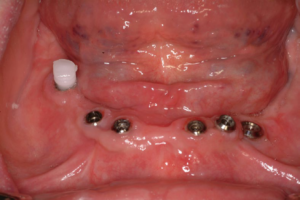
3. Prepare an occlusal opening in the denture in the area corresponding to the location of bite registration aid (Figure 2)
Figure 2: Prepare an occlusal opening the denture to accommodate the bite registration aid.
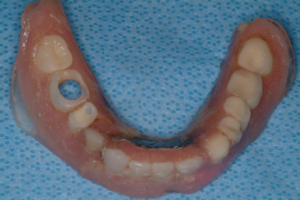
4. Seat the existing complete denture and make sure that the bite registration aid is below the occlusal surface.
5. Lubricate the prepared denture and opposing teeth with petroleum jelly (Pearson Lab Supplies, Sylmar, CA, USA).
6. Add a small amount of auto polymerizing pattern resin (GC America, Alsip, IL, USA) to the top of bite registration aid and ask patient to occlude in the established occlusal position (Figure 3).
Figure 3: Seat the mandibular complete denture and add a small amount of pattern resin on top of the bite registration aid. Ask patient to occlude using a previously determined position on the existing complete denture.
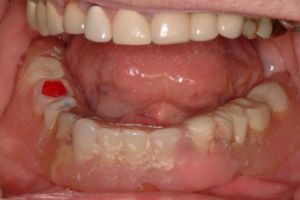
7. Wait until the pattern resin sets and remove the complete denture (Figure 4).
Figure 4: Remove the denture and leave the bite registration record in place.
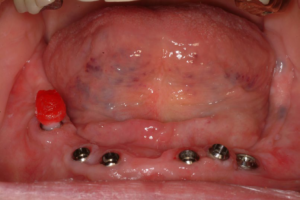
8. Insert a second bite registration aid on an anterior implant and repeat steps 3 to 7.
9. Insert a third bite registration aid on a contra-lateral posterior implant and repeat steps 3 to 7 to establish a tripod support (minimal number of support).
10. (Optional) Insert additional bite registration aids on other implants and repeat steps 3 to 7.
11. Connect the individual bite registration aids with pattern resin to acquire a jaw relation record (Figure 5).
Figure 5: Connect bite registration aids with pattern resin (after repeating the steps illustrated in figures (1-4) to record jaw relation in multiple implant locations).
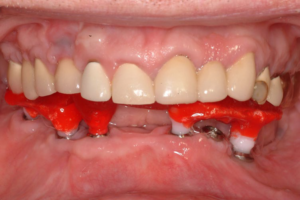
12. Take a face bow transfer and mount the casts by using the jaw relation record (Figure 6).
Figure 6: Mount the casts using the acquired jaw relation record.
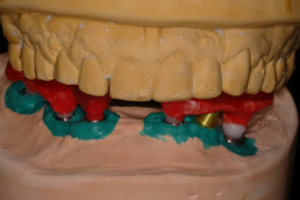
13. Repair the denture with auto polymerizing acrylic.
DISCUSSION
The described technique can facilitate the accurate transfer of jaw relations from existing conventional complete denture to implant-supported complete denture. It is simple, economical and can significantly reduce the number of visits needed to fabricate implant retained prosthesis. In order to minimize the shrinkage of pattern resin, it is advisable that one bite registration be performed at a time. However, it is also acceptable for clinicians to prepare multiple occlusal openings in the dentures and insert several bite registration aids at the same time. Other materials can also be used to obtain jaw relation records (e.g. elastomeric bite registration material, etc.). Although a Straumann bite registration aid is used in the aforementioned case, any commercially available implant system can use this technique with modifications. Screw-retained temporary abutments instead of a Straumann bite registration aid can be used if such is the case. Temporary abutments need to be modified to be below the occlusal surface in order to provide room for the occlusal registration material. After having obtained occlusal registration (step 6), a small screw access hole in the center of the pattern resin needs to be drilled for the registration device to be removed. To achieve sufficient stability, a slightly larger occlusal opening (and thus a larger recording pattern resin) is required to accommodate a patent screw access hole.
ACKNOWLEDGEMENT
The authors would like to thank Dr. Biyun Wu for critically reading the manuscript and final editing.
CONFLICTS OF INTEREST
The authors have no conflicts of interest to declare.











